A National Innovation System Concept-Based Analysis of Autonomous Vehicles’ Potential in Reaching Zero-Emission Fleets
Abstract
:1. Introduction
- (1)
- How can innovation activities in Lithuania in the field of autonomous mobility be analyzed in a broader National Innovation System?
- (2)
- Do the Lithuanian energy targets suffice the need to address the wider adoption and implementation of autonomous vehicles?
- (3)
- What are the expected transport fleet shift scenarios until 2050 in Lithuania and their effect on GHG emissions?
- (4)
- What is the current standing of Lithuania among EU countries and what can be expected on a long-term horizon in view of the NIS analysis?
2. Materials and Methods
- Passenger Cars M1.
- Light-Duty Vehicles N1.
- Heavy-Duty Vehicles N2, N3.
- Fuel consumed and quality of each fuel type.
- Emission controls fitted to a vehicle in the fleet.
- Operating characteristics (e.g., average speed per vehicle type and per road).
- Types of roads.
- Maintenance.
- Fleet age distribution.
- Distance driven (mean trip distance).
- Climate.
3. Results
3.1. The National Innovation System
3.1.1. Assessment of Prerequisites for Further Development of Lithuanian Energy and Transport Sectors
- -
- 2020–2029: EVs have limited charging flexibility.
- -
- 2030–2050: EV, mobility-as-a-service, and AV can change charging hours throughout the day.
3.1.2. Indicators of Industry Transformation
3.1.3. The Milestones of the Lithuanian Artificial Intelligence Strategy
- EE-LV-LT Via Baltica (E67) Tallinn (EE)—Riga (LV)—Kaunas (LT)—Lithuanian/Polish border;
- LT-PL Via Baltica Kaunas-Warsaw (and further a national extension between Kaunas and Vilnius (LT)).
3.1.4. National Industry 4.0 Platform
3.1.5. European Cooperation in Science and Technology: A Focus of Research for the Smart and Sustainable Mobility
3.2. Emission Scenarios (The Vision of Lithuania toward Decarbonization of the Transport Sector by 2050)
3.3. Lithuania’s Standings in the Context of EU Countries
4. Conclusions
- This study on Lithuania’s National Innovation System directs attention to the linkages or web of interaction within the overall innovation system. An understanding of NIS can help policy makers develop approaches for enhancing innovative performance in the knowledge-based economies of the future as it depends on the fluidity of knowledge flows—among the business environment, environment producing knowledge, and cooperation in science and technology.
- The expected transport fleet shift scenarios reveal that by 2030, there will be a significant reduction up to 38% in the CO2 emission from PC but a raise of 7% in CO2 emission from LDV and HDV. The slow transition toward the zero-emission fleet is expected to reflect evidently in 2050 with up to an ~85% reduction in CO2 emission from HDV (compared to 2021 levels) and achievement of 100% carbon neutrality in the PC segment, which will be dominated mostly by zero-emission vehicles.
- The energy efficiency targets reveal that ~20TWh of energy is expected to be saved by transportation reforms by 2030. The change in transportation will surge the energy demand by 7% in 2030, which will raise to 45% in 2050 in comparison to the energy consumption via transportation in 2020. In view of existing reforms and innovative entrepreneurship activities, which are considered a key factor of modern economic development, the Lithuanian energy sector is believed to be fully capable to ensure the projected energy demand for 2050.
- Lithuania falls within the top 30 countries in the world according to AV adoption readiness with the population size of 2.8 million: according to road quality, it is ranked 9th in the EU and 19th worldwide, and according to AV regulation, it is ranked 2nd—15th in the EU and 6th—21st worldwide. Currently, the absence of AV companies with over USD 50 million investment is seen as the biggest challenge to increase the overall AV readiness score; however, our study expects that a well-established National Innovation System can generate several new technologies and services that are first tested and deployed in the domestic market, which will influence changes in foreign direct investment flows over the next decade.
Author Contributions
Funding
Institutional Review Board Statement
Data Availability Statement
Acknowledgments
Conflicts of Interest
Abbreviations
| Latin symbols | |
| AI | Artificial Intelligence |
| AM | Autonomous Mobility |
| AV | Autonomous Vehicle |
| CH4 | Methane |
| CO2 | Carbon Dioxide |
| CO2 Eq | Carbon Dioxide Equivalent |
| EHIGHWAY | Emissions from Highway Driving Conditions |
| ERURAL | Emissions from Rural Driving Conditions |
| ETOTAL | Total Emissions from Different Driving Conditions |
| EURBAN | Emissions from Urban Driving Conditions |
| EU | European Union |
| Euro 4 to Euro 6 | European Emission Standards |
| EV | Electric Vehicle |
| EVC | Electric Vehicle Charging Station |
| FCEV | Fuel-Cell Electric Vehicle |
| GHG | Greenhouse Gas |
| HDV | Heavy-Duty Vehicle |
| HEV | Hybrid Electric Vehicle |
| ICEV | Internal Combustion Engine Vehicle |
| ICEV-bio-LNG-D | Dual-Fuel Vehicle (bio-LNG and Diesel Fuel) |
| ICT | Information and Communications Technology |
| LDV | Light-Duty Vehicle |
| LNG | Liquefied Natural Gas |
| M1, M2, M3 | Vehicle Categories Defined in the Consolidated Resolution on the Construction of Vehicles |
| N1, N2, N3 | Vehicle Categories Defined in the Consolidated Resolution on the Construction of Vehicles |
| N2O | Nitrous Oxide |
| NIS | The National Innovation System |
| PC | Passenger Car |
| PHEV | Plug-in Hybrid Electric Vehicle |
References
- Taiebat, M.; Brown, A.L.; Safford, H.R.; Qu, S.; Xu, M. A Review on energy, environmental, and sustainability implications of connected and automated vehicles. Environ. Sci. Technol. 2018, 52, 11449–11465. [Google Scholar] [CrossRef]
- Brown, K.E.; Dodder, R. Energy and emissions implications of automated vehicles in the U.S. energy system. Transp. Res. D Transp. Environ. 2019, 77, 132–147. [Google Scholar] [CrossRef]
- Xiaofeng, T. Ecological driving on multiphase trajectories and multiobjective optimization for autonomous electric vehicle platoon. Sci. Rep. 2022, 12, 5209. [Google Scholar] [CrossRef]
- Alsalman, A.; Assi, L.N.; Ghotbi, S.; Ghahari, S.A.; Shubbar, A. Users, planners, and governments perspectives: A public survey on autonomous vehicles future advancements. Transport. Eng. 2021, 3, 100044. [Google Scholar] [CrossRef]
- Silva, O.; Cordera, R.; González-González, E.; Nogués, S. Environmental impacts of autonomous vehicles: A review of scientific literature. Sci. Total Environ. 2022, 830, 154615. [Google Scholar] [CrossRef] [PubMed]
- Moody, J.; Bailey, N.; Zhao, J. Public perceptions of autonomous vehicle safety: An international comparison. Safety Sci. 2020, 121, 634–650. [Google Scholar] [CrossRef]
- Rezaei, A.; Caulfield, B. Safety of autonomous vehicles: What are the insights from experienced industry professionals? Transp. Res. Part F Traffic Psychol. Behav. 2021, 81, 472–489. [Google Scholar] [CrossRef]
- Sadaf, M.; Iqbal, Z.; Javed, A.R.; Saba, I.; Krichen, M.; Majeed, S.; Raza, A. Connected and Automated Vehicles: Infrastructure, Applications, Security, Critical Challenges, and Future Aspects. Technologies 2023, 11, 117. [Google Scholar] [CrossRef]
- Chung, J.Y. The National Innovation System (NIS) and the Automobile Industry in South Korea. In Fraunhofer ISI Discussion Papers Innovation Systems and Policy Analysis No. 29; Fraunhofer ISI: Karlsruhe, Germany, 2011; Available online: https://www.isi.fraunhofer.de/content/dam/isi/dokumente/cci/innovation-systems-policy-analysis/2011/discussionpaper_29_2011.pdf (accessed on 8 September 2023).
- Schade, W. Comparison of innovation systems of different transport modes and the need for public intervention. Transp. Res. Procedia 2016, 14, 4105–4112. [Google Scholar] [CrossRef]
- Grimm, A.; Walz, R. Current and future roles of the automotive and ICT sectoral systems in autonomous driving—Using the innovation system approach to assess value chain transformation. Technol. Forecast. Soc. Chang. 2024, 198, 122990. [Google Scholar] [CrossRef]
- Gandia, R.M.; Veroneze, R.B.; Antonialli, F.; Cavazza, B.H.; Sugano, J.Y.; Nicolai, I. The quintuple Helix Model and the future of mobility: The role of autonomous vehicles in a developing country. Rev. Adm. 2020, ffhalshs-03687627. [Google Scholar]
- Golichenko, O. The methodology of national innovation system analysis. In Quality Innovation: Knowledge, Theory, and Practices, 1st ed.; Al-Hakim, L., Jin, C., Eds.; IGI Global: Hershey, PA, USA, 2013; pp. 94–123. [Google Scholar]
- Zimm, C. Improving the understanding of electric vehicle technology and policy diffusion across countries. Transp. Policy 2021, 105, 54–66. [Google Scholar] [CrossRef]
- Altenburg, T.; Schamp, E.W.; Chaudhary, A. The emergence of electromobility: Comparing technological pathways in France, Germany, China and India. Sci. Publ. Pol. 2015, 43, 464–475. [Google Scholar] [CrossRef]
- The Technology and Innovation Report 2023. United Nations Publication Issued by the United Nations Conference on Trade and Development; UN: Geneva, Switzerland, 2023; Available online: https://unctad.org/tir2023 (accessed on 8 September 2023).
- IMD World Competitiveness Center. International Institute for Management Development (IMD) World Digital Competitiveness Ranking 2023. Available online: https://www.imd.org/centers/wcc/world-competitiveness-center/rankings/world-digital-competitiveness-ranking/ (accessed on 8 September 2023).
- Energy Policies of International Energy Agency Countries. United States 2019 Review. International Energy Agency, Official Website. Available online: https://iea.blob.core.windows.net/assets/7c65c270-ba15-466a-b50d-1c5cd19e359c/United_States_2019_Review.pdf (accessed on 20 October 2023).
- Crute, J.; Riggs, W.; Chapin, T.S.; Stevens, L. Planning for Autonomous Mobility—PAS Report 592. American Planning Association; 1 September 2018. Available online: https://www.waco-texas.com/userfiles/cms-mpo/file/2019%20CAV_PB/04%20APR%2018/4_0_PAS-Report-592_Plan%20for%20Autonomous%20Mobility.pdf (accessed on 25 October 2023).
- Autonomous Vehicle Policy Framework: Selected National and Jurisdictional Policy Efforts to Guide Safe AV Development. Insight Report, November 2020. World Economic Forum; Cologny/Geneva, Switzerland. Available online: https://www3.weforum.org/docs/WEF_C4IR_Israel_Autonomous_Vehicle_Policy_Framework_2020.pdf (accessed on 27 October 2023).
- Witkamp, B.; van Gijlswijk, R.N.; Bolech, M.; Coosemans, T.; Hooftman, N. The Transition to a Zero Emission Vehicles Fleet for Cars in the EU by 2050. Pathways and Impacts: An Evaluation of Forecasts and Backcasting the COP21 Commitments. A Policy Support Study Carried Out as Part of the EAFO Project for the European Commission Directorate General Mobility & Transport; TNO Report 874999; EAFO; European Commission: Brussel, Belgium, 2017; Available online: https://repository.tno.nl/islandora/object/uuid%3A36e531b4-66e6-4b66-83b5-beb3f2c01fce (accessed on 29 October 2023).
- Dror, M.B.; Vyakarnam, J.; Hannon, E. How to Scale-Up Investment in Sustainable Mobility. World Economic Forum (The International Organization for Public-Private Cooperation). Available online: https://www.weforum.org/agenda/2021/09/how-to-scale-up-investment-sustainable-mobility (accessed on 20 January 2022).
- STRIA Roadmap on Connected and Automated Transport Road, Rail and Waterborne. The Transport Research and Innovation Monitoring and Information System, Official Website. 2019. Available online: https://trimis.ec.europa.eu/sites/default/files/2021-10/stria_roadmap_2019-connected_and_automated_transport.pdf (accessed on 20 January 2023).
- Autonomous Vehicles: Rules on Safe Use of Automated Vehicles on Great Britain roads. Applies to England, Scotland and Wales. The UK Government, Official Website. Available online: https://www.gov.uk/government/consultations/safe-use-rules-for-automated-vehicles-av/rules-on-safe-use-of-automated-vehicles-on-gb-roads (accessed on 21 January 2022).
- Bahamonde-Birke, F.J.; Goletz, M.; Ettema, D. The provision of mobility as a service with autonomous vehicles. The necessity of regulatory schemes for a natural monopoly. Res. Transp. Econ. 2020, 90, 100993. [Google Scholar] [CrossRef]
- Global Innovation Index 2023. World Intellectual Property Organization, Official Website. Available online: https://www.wipo.int/edocs/pubdocs/en/wipo-pub-2000-2023-section1-en-gii-2023-at-a-glance-global-innovation-index-2023.pdf (accessed on 10 January 2024).
- Tan, S.Y.; Taeihagh., A. Adaptive governance of autonomous vehicles: Accelerating the adoption of disruptive technologies in Singapore. Gov. Inf. Q. 2021, 38, 101546. [Google Scholar] [CrossRef]
- Ki, J. A comparative analysis of autonomous vehicle policies among Korea, Japan, and France. HAL 2020, ffhal-0256248. Available online: https://hal.archives-ouvertes.fr/hal-02562482 (accessed on 21 December 2022).
- Maeng, K.; Cho, Y. Who will want to use shared autonomous vehicle service and how much? A consumer experiment in South Korea. Travel. Behav. Soc. 2022, 26, 17. [Google Scholar] [CrossRef]
- Autonomous Vehicles Readiness Index (AVRI) 2020. KPMG International, Publication number: 136956-G. July 2020. Available online: https://assets.kpmg/content/dam/kpmg/es/pdf/2020/07/2020_KPMG_Autonomous_Vehicles_Readiness_Index.pdf (accessed on 21 December 2022).
- 2050 Climate Neutrality Roadmap for Korea. K-Map Scenario. Green Energy Strategy Institute, Institute for Green Transformation, NEXT Group, Agora Energiewende. 2022. Available online: https://static.agora-energiewende.de/fileadmin/Projekte/2021/2021_04_INT_Korea_Map/K-Map_EN_final.pdf (accessed on 21 December 2022).
- Reaching Zero Emissions by 2050 in the Japanese Energy System. Study on Behalf of Renewable Energy Institute and Agora Energiewende; Renewable Energy Institute, Agora Energiewende, LUT University. 2021. Available online: https://static.agora-energiewende.de/fileadmin/Projekte/2021/2021_03_JP_2050_study/2021_LUT-Agora-REI_Renewable_pathways_Study.pdf (accessed on 22 December 2022).
- EMISIA SA, the Spin-off Company of the Aristotle University of Thessaloniki, Official Website. Available online: https://www.emisia.com/news/copert-version-5-7-3/ (accessed on 5 January 2022).
- Lithuania’s Transport and Communications Development Strategy until 2050 (in Lithuanian). Approved by Order No. 3-746 (7 December 2020) of the Minister of Transport and Communications of the Republic of Lithuania. 2020. Available online: https://www.esinvesticijos.lt/uploads/main/documents/files/Post%202020/Programos%20rengimas/Strategija%202050%20m_%202020-12-07_Nr_%203-746(1).pdf (accessed on 8 January 2023).
- The European Green Deal. European Commission, Official Website. Available online: https://ec.europa.eu/info/sites/default/files/european-green-deal-communication_en.pdf (accessed on 8 January 2023).
- International Energy Agency. Lithuania 2021: Energy Policy Review. 2021. Available online: https://iea.blob.core.windows.net/assets/4d014034-0f94-409d-bb8f-193e17a81d77/Lithuania_2021_Energy_Policy_Review.pdf (accessed on 12 February 2023).
- Li, M.; Trencher, G.; Asuka, J. The clean energy claims of BP, Chevron, ExxonMobil and Shell: A mismatch between discourse, actions and investments. PLoS ONE 2022, 17, 0263596. [Google Scholar] [CrossRef]
- Polzin, F.; Sanders, M. How to finance the transition to low-carbon energy in Europe? Energy Policy 2020, 147, 111863. [Google Scholar] [CrossRef]
- Polzin, F. Mobilizing private finance for low-carbon innovation—A systematic review of barriers and solutions. Renew. Sust. Energy Rev. 2017, 77, 525–535. [Google Scholar] [CrossRef]
- Fadly, D. Low-carbon transition: Private sector investment in renewable energy projects in developing countries. World Dev. 2019, 122, 552–569. [Google Scholar] [CrossRef]
- Eikeland, P.O.; Skjærseth, J.B. The politics of low-carbon innovation: Implementing the European Union’s strategic energy technology plan. Energy Res. Soc. Sci. 2021, 76, 102043. [Google Scholar] [CrossRef]
- New Cohesion Policy. European Commission, Official Website. Available online: https://ec.europa.eu/regional_policy/en/2021_2027/ (accessed on 12 February 2023).
- European Commission, Official Website. EU Emissions Trading System. Available online: https://ec.europa.eu/clima/policies/ets_en (accessed on 26 February 2023).
- The Just Transition Fund, Official Website. Available online: www.justtransitionfund.org (accessed on 26 February 2023).
- Panoutsou, A.; Germer, S.; Karka, P.; Papadokostantakis, S.; Kroyan, Y.; Wojcieszy, M.; Maniatis, K.; Marchand, P.; Landalv, I. Advanced biofuels to decarbonise European transport by 2030: Markets, challenges, and policies that impact their successful market uptake. Energy Strateg. Rev. 2021, 34, 100633. [Google Scholar] [CrossRef]
- Løken, I.B.; Bartnes, G.; Dugstad, E.; Brenden, D.; Bjørndalen, J.; Berglund, F. Scenario Building for the Evolution of Lithuanian Power Sector for 2020–2050. Report: 2020-0430. DNV GL. Available online: https://lsta.lt/wp-content/uploads/2020/12/201217-Scenario-building-for-Lithuanian-electric-power-sector_final-report.pdf (accessed on 10 July 2023).
- Wrede, M. Electric Vehicle Charging Infrastructure in Europe 2021. Available online: https://www.intertraffic.com/news/infrastructure/electric-vehicle-charging-2021-europe (accessed on 10 July 2023).
- Oturakci, M. Comprehensive analysis of the global innovation index: Statistical and strategic approach. Technol. Anal. Strateg. Manag. 2023, 35, 676–688. [Google Scholar] [CrossRef]
- Huarng, K.-H.; Yu, T.H.-K. Analysis of Global Innovation Index by structural qualitative association. Technol. Forecast. Soc. Chang. 2022, 182, 121850. [Google Scholar] [CrossRef]
- Aytekin, A.; Ecer, F.; Korucuk, S.; Karamaş, C. Global innovation efficiency assessment of EU member and candidate countries via DEA-EATWIOS multi-criteria methodology. Technol. Soc. 2022, 68, 101896. [Google Scholar] [CrossRef]
- The Global Economy: Business and Economic Data for 200 Countries. Available online: https://www.theglobaleconomy.com (accessed on 11 October 2023).
- World Population by Country (2022). Available online: https://worldpopulationreview.com (accessed on 11 October 2023).
- McKinsey Global Institute. Notes from the AI Frontier—Modeling the Impact of AI on the World Economy, Discussion Paper. Available online: https://www.mckinsey.com/featured-insights/artificial-intelligence/notes-from-the-ai-frontier-modeling-the-impact-of-ai-on-the-world-economy (accessed on 11 October 2023).
- Kaplan, A.; Haenlein, M. Siri, Siri, in my hand: Who’s the fairest in the land? On the interpretations, illustrations, and implications of artificial intelligence. Bus. Horizons 2019, 62, 15–25. [Google Scholar] [CrossRef]
- Hassani, H.; Silva, E.S.; Unger, S.; TajMazinani, M.; Mac Feely, S. Artificial intelligence (AI) or intelligence augmentation (IA): What is the future? Artif. Intell. 2020, 1, 8. [Google Scholar] [CrossRef]
- Dang, J.; Liu, L. Implicit theories of the human mind predict competitive and cooperative responses to AI robots. Comput. Hum. Behav. 2022, 134, 107300. [Google Scholar] [CrossRef]
- European Commission, Official Website. Member States and Commission to Work Together to Boost Artificial Intelligence “Made in Europe”. Available online: https://ec.europa.eu/commission/presscorner/detail/en/IP_18_6689 (accessed on 15 November 2023).
- Lithuanian Artificial Intelligence Strategy. A Vision of the Future; 2018. Ministry of the Economy and Innovation of the Republic of Lithuania, Official Website. Available online: https://eimin.lrv.lt/uploads/eimin/documents/files/DI_strategija_ENG(1).pdf (accessed on 15 February 2022).
- Richter, L.; Lehna, M.; Marchand, S.; Scholz, C.; Dreher, A.; Klaiber, S.; Lenk, S. Artificial intelligence for electricity supply chain automation. Renew. Sust. Energy Rev. 2022, 163, 112459. [Google Scholar] [CrossRef]
- Ahmad, T.; Zhang, D.; Huanga, C.; Zhang, H.; Dai, N.; Song, Y.; Chen, H. Artificial intelligence in sustainable energy industry: Status Quo, challenges and opportunities. J. Clean. Prod. 2021, 289, 125834. [Google Scholar] [CrossRef]
- Hetzer, D.; Muehleisen, M.; Kousaridas, A.; Barmpounakis, S.; Wendt, S.; Eckert, K.; Schimpe, A.; Löfhede, J.; Alonso-Zarate, J. 5G connected and automated driving: Use cases, technologies and trials in cross-border environments. J. Wirel. Com. Netw. 2021, 2021, 97. [Google Scholar] [CrossRef] [PubMed]
- 5G Observatory—Tracking 5G Developments. Available online: https://5gobservatory.eu/info-deployments/pan-eu-5g-corridors (accessed on 20 July 2022).
- Liu, J.; Qian, Y.; Yang, Y.; Yang, Z. Can artificial intelligence improve the energy efficiency of manufacturing companies? Evidence from China. Int. J. Environ. Res. Public Health 2022, 19, 2091. [Google Scholar] [CrossRef] [PubMed]
- Castelo-Branco, I.; Cruz-Jesus, F.; Oliveira, T. Assessing Industry 4.0 readiness in manufacturing: Evidence for the European Union. Comput. Ind. 2019, 107, 22–32. [Google Scholar] [CrossRef]
- Lithuanian Industry Digitisation Roadmap 2020–2030. Lithuanian Innovation Center. Vilnius, 31/10/2020. Ministry of the Economy and Innovation of the Republic of Lithuania, Official Website. Available online: https://eimin.lrv.lt/uploads/eimin/documents/files/Lithuanian%20Industry%20Digitisation%20Roadmap%202020-2030%20UPDATED%20EN%20(1).pdf (accessed on 16 July 2022).
- Saraji, M.K.; Streimikiene, D.; Kyriakopoulos, G.L. Fermatean Fuzzy CRITIC-COPRAS method for evaluating the challenges to Industry 4.0 adoption for a sustainable digital transformation. Sustainability 2021, 13, 9577. [Google Scholar]
- Research Council of Lithuania, Official Webpage. Available online: https://informacija.lmt.lt/COST/ (accessed on 15 February 2022).
- High Precision Positioning for Cooperative ITS Applications (HIGHTS); Grant Agreement ID: 636537. The Community Research and Development Information Service (CORDIS), Official Webpage. Available online: https://cordis.europa.eu/project/id/636537 (accessed on 1 December 2023).
- Enabling Safe Multi-Brand Platooning for Europe (ENSEMBLE), Grant Agreement ID: 769115. Available online: https://cordis.europa.eu/project/id/769115 (accessed on 1 December 2023).
- Managing Automated Vehicles Enhances Network (MAVEN); Grant Agreement ID: 690727. CORDIS, Official Webpage. Available online: https://cordis.europa.eu/project/id/690727 (accessed on 1 December 2023).
- Adaptive ADAS to Support Incapacitated Drivers Mitigate Effectively Risks through Tailor Made HMI under Automation (ADAS&me); Grant Agreement ID: 688900. CORDIS, Official Webpage. Available online: https://cordis.europa.eu/project/id/688900 (accessed on 2 December 2023).
- Trial and Validate the Interoperability between EU and China 5G Networks (5G-DRIVE); Grant Agreement ID: 814956. CORDIS, Official Webpage. Available online: https://cordis.europa.eu/project/id/814956 (accessed on 2 December 2023).
- ICT Infrastructure for Connected and Automated Road Transport (ICT4CART); Grant Agreement ID: 768953. Available online: https://cordis.europa.eu/project/id/768953 (accessed on 8 December 2023).
- Enhance Driver Behavior and Public Acceptance of Connected and Automated Vehicles (PAsCAL); Grant Agreement ID: 815098. Available online: https://cordis.europa.eu/project/id/815098 (accessed on 8 December 2023).
- Raising Automated Vehicles Users’ Acceptance for All Transport Modes (DRIVE2THEFUTURE); Grant Agreement ID: 815001. Available online: https://cordis.europa.eu/project/id/815001 (accessed on 8 December 2023).
- Needs and Opportunities for Zero Emissions, Renewable Energy and the Use of Transitional Alternative Fuels in the Transport Sector (S-REP-22-7). Research Council of Lithuania (RCL), Need-Driven Research Projects. 2023. Available online: https://en.ktu.edu/projects/needs-and-opportunities-for-zero-emissions-renewable-energy-and-the-use-of-transitional-alternative-fuels-in-the-transport-sector/ (accessed on 9 December 2023).
- Holistic Approach for Providing Spatial and Transport Planning Tools and Evidence to Metropolitan and Regional Authorities to Lead a Sustainable Transition to a New Mobility Era (HARMONY); Grant Agreement ID: 815269. Available online: https://cordis.europa.eu/project/id/815269 (accessed on 9 December 2023).
- Artificial Intelligence Based Cybersecurity for Connected and Automated Vehicles (CARAMEL); Grant Agreement ID: 833611. Available online: https://cordis.europa.eu/project/id/833611 (accessed on 9 December 2023).
- Holistic Approach for Driver Role Integration and Automation Allocation for European Mobility Needs (HADRIAN); Grant Agreement ID: 875597. Available online: https://cordis.europa.eu/project/id/875597 (accessed on 12 December 2023).
- Shared Automation Operating Models for Worldwide Adoption (SHOW); Grant Agreement ID: 875530. Available online: https://cordis.europa.eu/project/id/875530 (accessed on 12 December 2023).
- Monetizing Car and Mobility Data for New Entrants, Technologies and Actors (5GMETA); Grant Agreement ID: 957360. Available online: https://cordis.europa.eu/project/id/957360 (accessed on 12 December 2023).
- 5th Generation Connected and Automated Mobility Cross-Border EU Trials (5G-ROUTES); Grant Agreement ID: 951867. Available online: https://cordis.europa.eu/project/id/951867 (accessed on 12 December 2023).
- Sustainable 5G Deployment Model for Future Mobility in the Mediterranean Cross-Border Corridor (5GMED); Grant Agreement ID: 951947. Available online: https://cordis.europa.eu/project/id/951947 (accessed on 12 December 2023).
- Enabled Smart Road Infrastructure Usage and Maintenance for Increased Energy Efficiency and Safety on European Road Networks (EGNSS); Grant Agreement ID: 101004181. Available online: https://cordis.europa.eu/project/id/101004181 (accessed on 16 December 2023).
- All Weather Autonomous Real Logistics Operations and Demonstrations (AWARD); Grant Agreement ID: 101006817. Available online: https://cordis.europa.eu/project/id/101006817 (accessed on 16 December 2023).
- Next Generation Traffic Management for Empowering CAVs Integration, Cross-Stakeholders Collaboration and Proactive Multi-Modal Network Optimization (FRONTIER); Grant Agreement ID: 955317. Available online: https://cordis.europa.eu/project/id/955317 (accessed on 16 December 2023).
- Astafjev, J. Personal Communication, 28 June 2022. Available online: https://www.linkedin.com/posts/jurij-astafjev-3733884_sankey-co2-ghgemissions-activity-6754764382623825920-UN_H/?utm_source=share&utm_medium=member_desktop (accessed on 20 January 2024).
- Konstantinavičiūtė, I.; Byčenkienė, S.; Vilniškė, L.; Juška, R.; Žiukelytė, I.; Lenkaitis, R.; Kazanavičiūtė, V. Lithuania’s National Inventory Report 2021. Vilnus. 2021. Available online: https://am.lrv.lt/uploads/am/documents/files/KLIMATO%20KAITA/%C5%A0ESD%20apskaitos%20ir%20kt%20ataskaitos/NIR_2021_01_15%20FINAL.pdf (accessed on 6 May 2022).
- State Enterprise Regitra, Official Website. Available online: https://www.regitra.lt/en (accessed on 5 January 2022).
- Miskolczi, M.; Foldes, D.; Munkacsy, A.; Jaszberenyi, M. Urban mobility scenarios until the 2030s. Sustain. Cities Soc. 2021, 72, 103029. [Google Scholar] [CrossRef]
- Vermeulen, R.J. Emissions Testing of a Euro VI LNG-Diesel Dual Fuel Truck in The Netherlands; 2019-STL-RAP-100320745; TNO: Den Haag, The Netherlands, 2019; Available online: http://resolver.tudelft.nl/uuid:1a455afb-ac09-477e-a851-112904eb3384 (accessed on 4 June 2022).
- Nijenhuis, M. In-Service Conformity Test on a Volvo FH420 LNG-Diesel Dual Fuel Truck with a Euro VI step C Certified Engine; TNO 2019 R10014; TNO: Den Haag, The Netherlands, 2019; Available online: http://resolver.tudelft.nl/uuid:c32a5620-9ba6-4f9d-b381-0e24e2ddcff2 (accessed on 5 June 2022).
- Raslavičius, L.; Keršys, A.; Mockus, S.; Keršienė, N.; Starevičius, M. Liquefied petroleum gas (LPG) as a medium-term option in the transition to sustainable fuels and transport. Renew. Sust. Energy Rev. 2014, 32, 513–525. [Google Scholar] [CrossRef]
- Grigoratos, T.; Fontaras, G.; Giechaskiel, B.; Zacharof, N. Real world emissions performance of heavy-duty Euro VI diesel vehicles. Atmos. Environ. 2019, 201, 348–359. [Google Scholar] [CrossRef]
- Breed, A.K.; Speth, D.; Plötz, P. CO2 fleet regulation and the future market diffusion of zero-emission trucks in Europe. Energy Policy 2021, 159, 112640. [Google Scholar] [CrossRef]
- Fauré, E.; Arushanyan, Y.; Ekener, E.; Miliutenko, S.; Finnveden, G. Methods for assessing future scenarios from a sustainability perspective. Eur. J. Futures Res. 2017, 5, 17. [Google Scholar] [CrossRef]
- Krause, J.; Thiel, C.; Tsokolis, D.; Samaras, Z.; Rota, C.; Ward, A.; Prenninger, P.; Coosemans, T.; Neugebauer, S.; Verhoeve, W. EU road vehicle energy consumption and CO2 emissions by 2050—Expert-based scenarios. Energy Policy 2020, 138, 111224. [Google Scholar] [CrossRef]
- French State-Owned International News Television Network, Official Website. EU Approves End of Combustion Engine Sales by 2035. Available online: https://www.france24.com/en/live-news/20220629-eu-approves-end-of-combustion-engine-sales-by-2035 (accessed on 17 September 2022).
- Hill, N.; Amaral, S.; Morgan-Price, S.; Nokes, T.; Bates, J.; Helms, H.; Fehrenbach, H.; Biemann, K. Determining the Environmental Impacts of Conventional and Alternatively Fuelled Vehicles through LCA. Final Report for the European Commission, DG Climate Action. Contract Ref. 34027703/2018/782375/ETU/CLIMA.C.4. 13/07/2020. Available online: https://op.europa.eu/lt/publication-detail/-/publication/1f494180-bc0e-11ea-811c-01aa75ed71a1 (accessed on 17 September 2022).
- Syré, A.M.; Heining, F.; Göhlich, D. Method for a multi-vehicle, simulation-based life cycle assessment and application to Berlin’s motorized individual transport. Sustainability 2020, 12, 7302. [Google Scholar] [CrossRef]
- Gibbs, J. The Top AV Ready Countries. Available online: https://www.confused.com/car-insurance/av-readiness (accessed on 16 January 2024).
- Technology and Innovation Report 2021: Catching Technological Waves, Innovation with Equity. United Nations Publication Issued by the United Nations Conference on Trade and Development; UN: Geneva, Switzerland, 2021; Available online: https://digitallibrary.un.org/record/3926808?ln=en (accessed on 17 September 2022).
- Nettel, P.F.; Rogerson, A.; Westgarth, T.; Iida, K.; Mbayo, H.; Finotto, A.; Rahim, S.; Petheram, A. Government AI Readiness Index 2021. Oxford Insights. 2021. Available online: https://static1.squarespace.com/static/58b2e92c1e5b6c828058484e/t/61e95661c567937d21998d14/1642681965033/Gov_AI_Readiness_2021.pdf (accessed on 17 September 2022).
- Lee, K.; Lee, J.; Lee, J. Variety of national innovation systems (NIS) and alternative pathways to growth beyond the middle-income stage: Balanced, imbalanced, catching-up, and trapped NIS. World Dev. 2021, 144, 105472. [Google Scholar] [CrossRef]
- Li, X.; Wu, T.; Zhang, H.-J.; Yang, D.-Y. National innovation systems and the achievement of sustainable development goals: Effect of knowledge-based dynamic capability. J. Innov. Knowl. 2023, 8, 100310. [Google Scholar] [CrossRef]


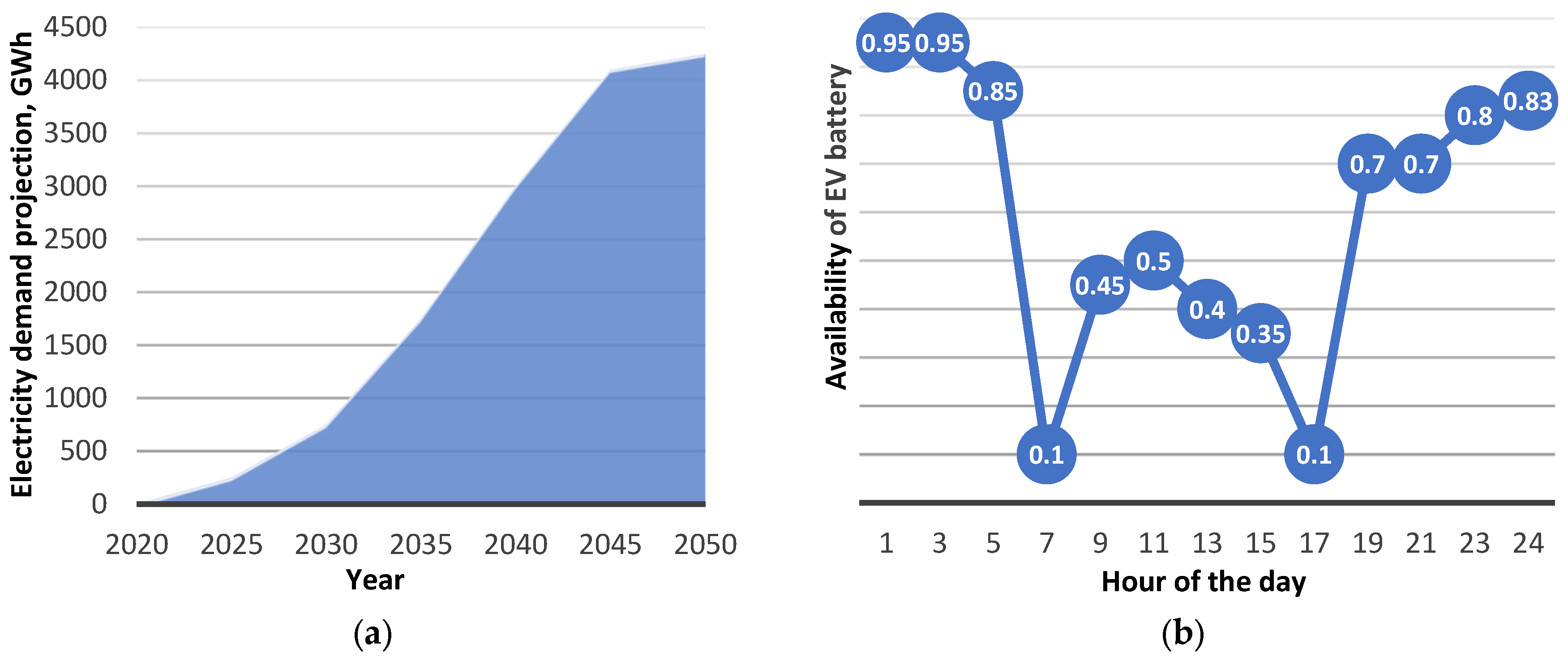
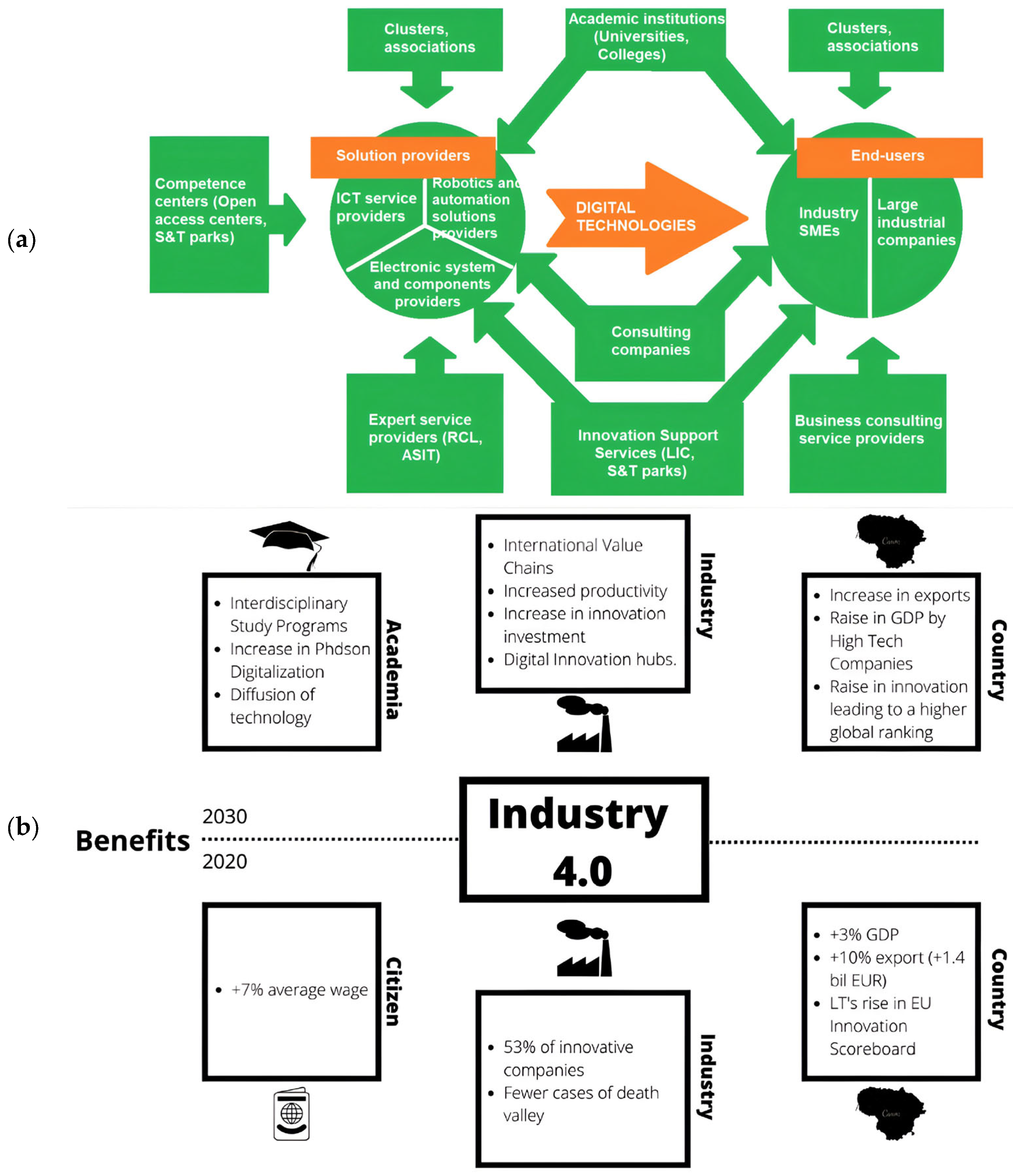
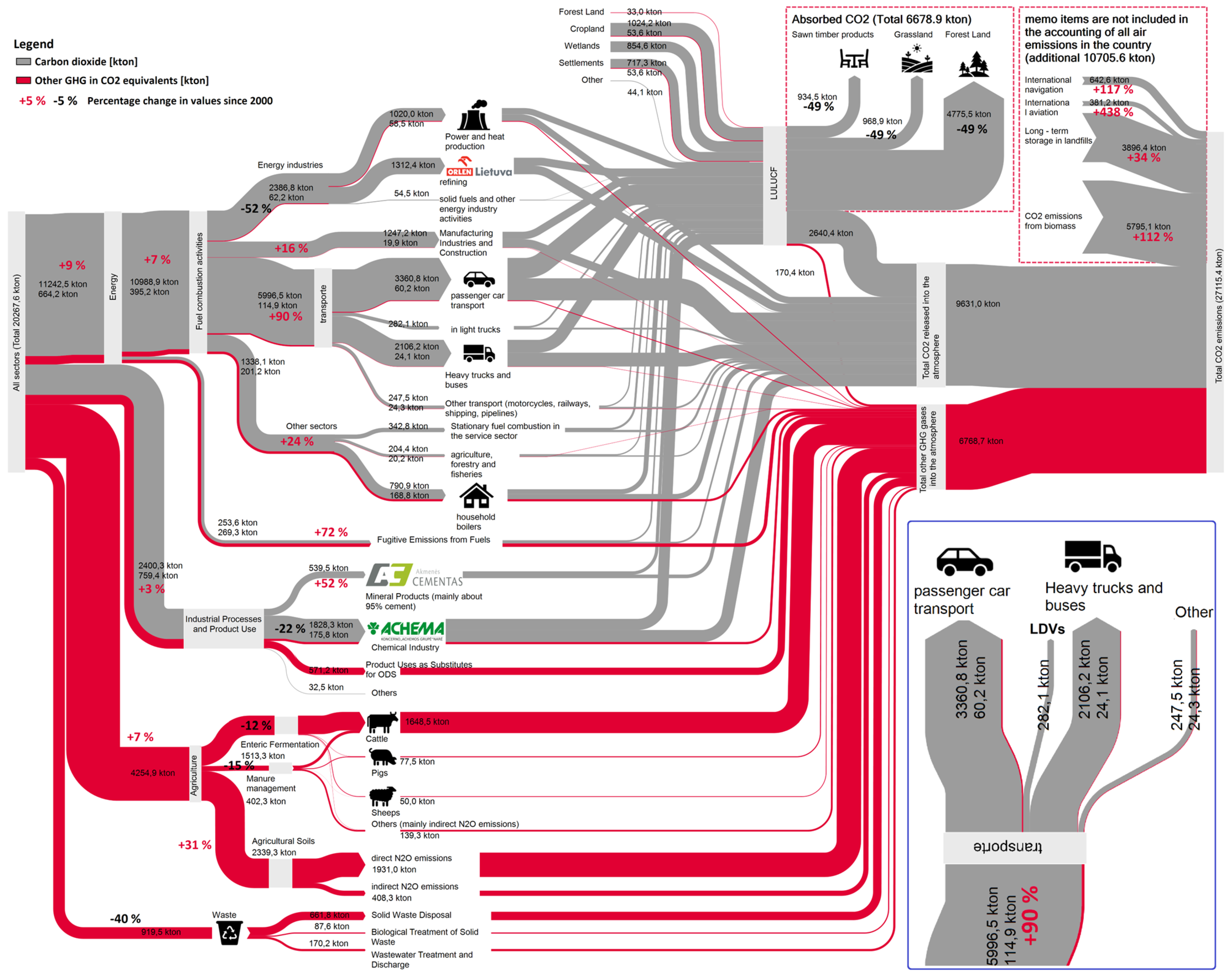

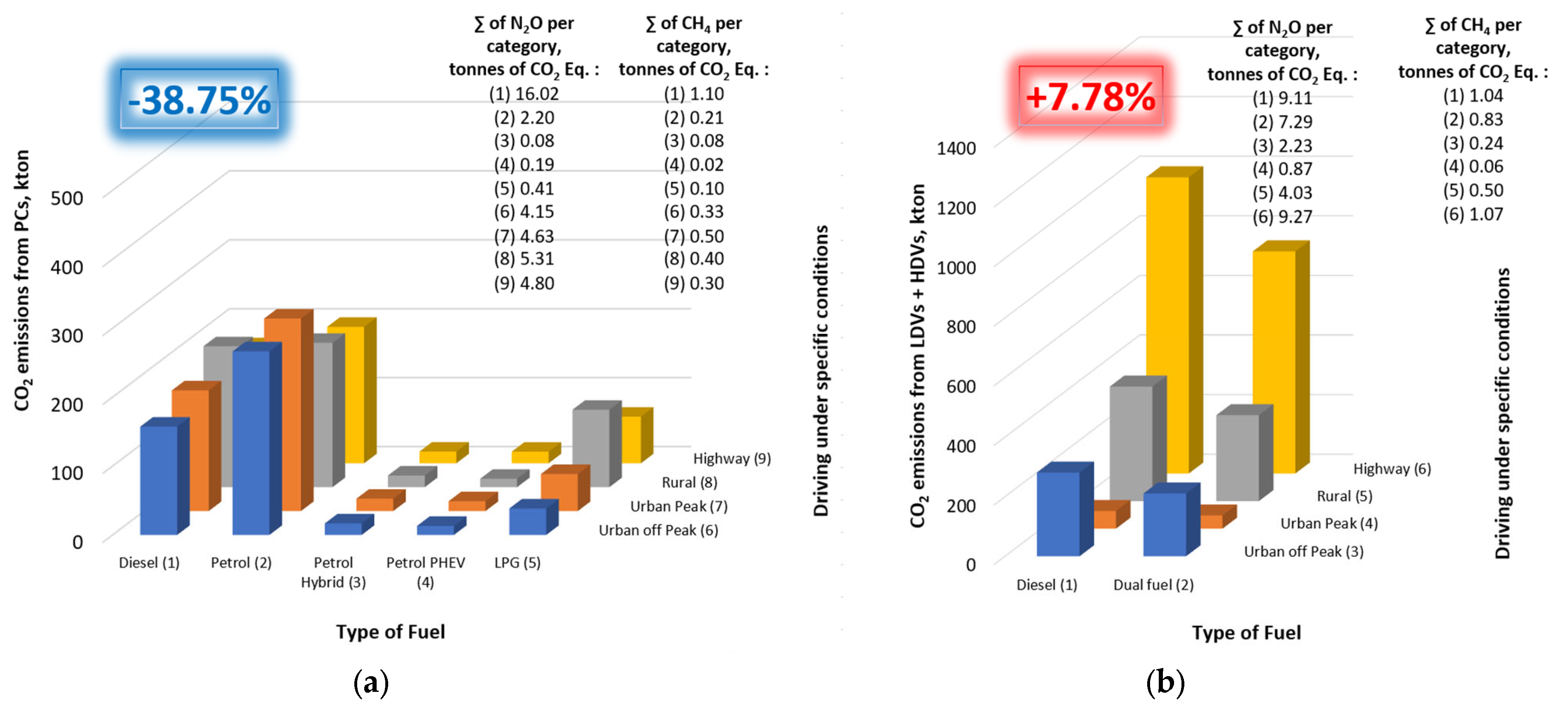
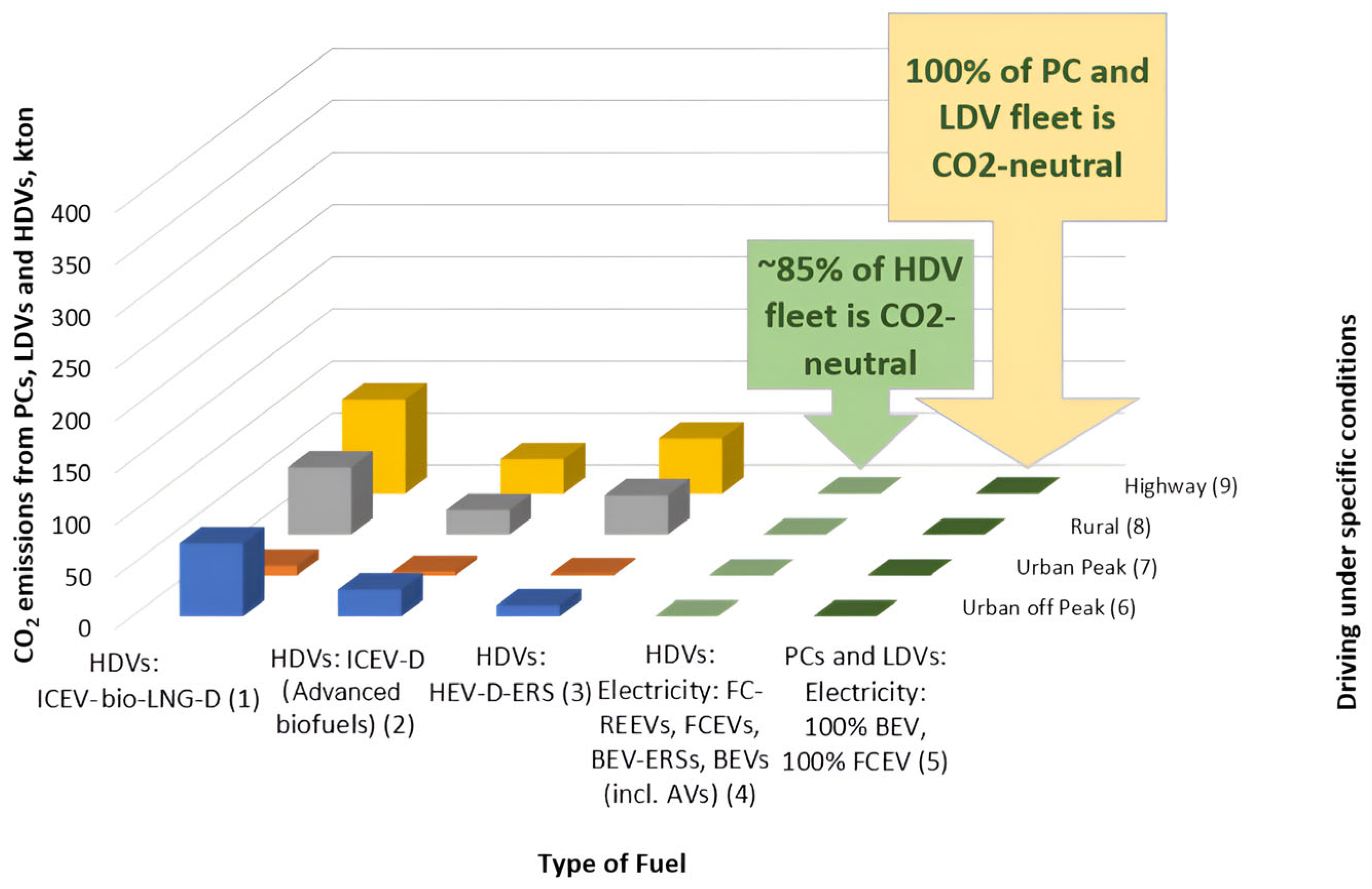
| Target Group | Description | Predicted Savings by 2030 |
|---|---|---|
| Sustainable urban mobility plans | Targets: Reduce car usage. Measures: Promote cycling, walking, public transport, and the use of alternative fuels. | 2.95 TWh |
| Fossil fuel | Targets: Increase fuel cost—petrol (+14.7%), diesel (+5.2%), LPG (+64.7%). Measures: Inflation in applicable excise duties and taxes on fuel consumption beyond EU norms. | 6 TWh |
| Electrification of rails | Targets: New electric power lines for 814 km of rail by 2030. Measures: EU funding during 2025–2035. | 3.36 TWh |
| Electric vehicles | Targets: 10% of registered and re-registered passenger cars by 2030 and 50% by 2050. Measures: EUR 4K subsidy for acquisition of new electric cars, and EUR 2K for used (max. 5 years) electric cars. | 6 TWh |
| Urban and suburban public fleet renewal | Targets: Implementing 150 electric-powered city and shuttle buses. Measures: EU funding during 2030–2025. | 0.393 TWh |
| Public fleet renewal and green procurement of clean vehicles | Targets: 60% of public fleet (M1, M2, and N1) and 80% of buses (M3) must be ‘clean’ by 2025; 100% of the fleet (M1, M2, and M3), 16% of heavy-duty vehicles (N2 and N3), and 50% of buses must be ‘clean’ by 2030. Measures: Public fleet switch. | 0.521 TWh |
| Efficient vehicles | Targets: 42% increase in the number of energy-efficient vehicles until 2030. Measures: EUR 1K subsidy. | 0.9 TWh |
| TWh | 2025 | 2030 | 2040 | 2050 |
|---|---|---|---|---|
| Annual gross electricity consumption | 13.64 | 14.47 | 17.77 | 19.81 |
| Annual gross load | 12.78 | 13.62 | 16.92 | 18.96 |
| Annual total load | 11.75 | 12.52 | 15.55 | 17.43 |
| No. | Code | Title | Period | Involvement of Lithuanian Institutions |
|---|---|---|---|---|
| 1 | TU 1004 | Modelling public transport passenger flows in the era of intelligent transport systems | 2010–2015 | – |
| 2 | TU 1102 | Toward autonomic road transport support systems | 2011–2015 | – |
| 3 | TU 1302 | SaPPART satellite positioning performance assessment for road transport | 2013–2017 | – |
| 4 | CA 16222 | Wider impacts and scenario evaluation of autonomous and connected transport | 2017–2022 | KTU |
| Rank | Country | Policy and Legislation | Technology and Innovation | Consumer Acceptance | Infrastructure | ||||
|---|---|---|---|---|---|---|---|---|---|
| Company Head Quarters | AV Patents | AV Companies with an over USD 50 Million Investment | Infrastructure per Million of Population | Road Quality/10 | Score/10 | ||||
| 1 | France | 2 | 2 | 5499 | 2 | 5.9% | 679 | 5.4 | 7.37 |
| 2 | Germany | 4 | 1 | 13,817 | 1 | −2.3% | 537 | 5.3 | 6.74 |
| 3 | Sweden | 2 | 1 | 4693 | 1 | 0.0% | 1.006 | 5.3 | 6.34 |
| 4 | Austria | 2 | 1 | 693 | 1 | −2.3% | 923 | 6.0 | 5.85 |
| 5 | Finland | 1 | 1 | 1078 | 1 | 5.2% | 674 | 5.3 | 5.54 |
| 6 | The Netherlands | 2 | 0 | 3918 | 0 | −6.1% | 3,822 | 6.4 | 4.78 |
| 7 | Spain | 2 | 0 | 2352 | 0 | 18.9% | 173 | 5.7 | 4.47 |
| 8 | Ireland | 2 | 1 | 639 | 1 | 0.0% | 217 | 4.4 | 4.38 |
| 9–10 | Belgium | 2 | 0 | 1278 | 0 | 2.9% | 734 | 4.4 | 3.53 |
| 9–10 | Denmark | 2 | 0 | 1456 | 0 | −20.4% | 558 | 5.6 | 3.53 |
| 11 | Portugal | 2 | 0 | 237 | 0 | −19.7% | 240 | 6.0 | 3.08 |
| 12 | Poland | 2 | 0 | 161 | 0 | 13.3% | 45 | 4.3 | 2.5 |
| 13 | Italy | 1 | 0 | 2716 | 0 | −0.2% | 225 | 4.4 | 2.45 |
| 14−15 | Hungary | 2 | 0 | 81 | 0 | 9.0% | 133 | 4.0 | 2.32 |
| 14–15 | Greece | 2 | 0 | 120 | 0 | 4.8% | 31 | 4.6 | 2.32 |
| 16 | Estonia | 2 | 0 | 131 | 0 | −15.6% | 319 | 4.7 | 2.28 |
| 17 | Lithuania | 2 | 0 | 28 | 0 | 3.7% | 64 | 4.8 | 2.14 |
| 18–27 | Other countries: Slovakia, Luxembourg, Croatia, Republic of Cyprus, Slovenia, Czech Republic, Latvia, Bulgaria, Malta, Romania | ||||||||
Disclaimer/Publisher’s Note: The statements, opinions and data contained in all publications are solely those of the individual author(s) and contributor(s) and not of MDPI and/or the editor(s). MDPI and/or the editor(s) disclaim responsibility for any injury to people or property resulting from any ideas, methods, instructions or products referred to in the content. |
© 2024 by the authors. Licensee MDPI, Basel, Switzerland. This article is an open access article distributed under the terms and conditions of the Creative Commons Attribution (CC BY) license (https://creativecommons.org/licenses/by/4.0/).
Share and Cite
Venkatesh, N.H.; Raslavičius, L. A National Innovation System Concept-Based Analysis of Autonomous Vehicles’ Potential in Reaching Zero-Emission Fleets. Technologies 2024, 12, 26. https://doi.org/10.3390/technologies12020026
Venkatesh NH, Raslavičius L. A National Innovation System Concept-Based Analysis of Autonomous Vehicles’ Potential in Reaching Zero-Emission Fleets. Technologies. 2024; 12(2):26. https://doi.org/10.3390/technologies12020026
Chicago/Turabian StyleVenkatesh, Nalina Hamsaiyni, and Laurencas Raslavičius. 2024. "A National Innovation System Concept-Based Analysis of Autonomous Vehicles’ Potential in Reaching Zero-Emission Fleets" Technologies 12, no. 2: 26. https://doi.org/10.3390/technologies12020026





